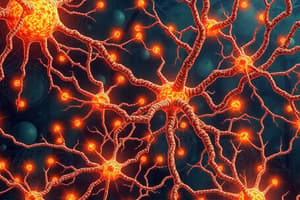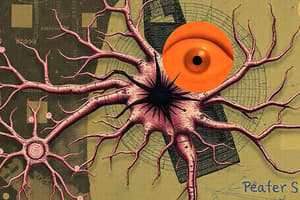Podcast
Questions and Answers
What is the primary function of a synapse?
What is the primary function of a synapse?
- To regulate the metabolic rate of neurons.
- To transmit information between neurons or between a neuron and another cell. (correct)
- To produce neurotransmitters within neurons.
- To provide structural support to neurons.
Which type of cell listed can be a postsynaptic cell in the peripheral nervous system?
Which type of cell listed can be a postsynaptic cell in the peripheral nervous system?
- Adipocyte
- Muscle cell (correct)
- Osteocyte
- Epithelial cell
What characterizes an electrical synapse?
What characterizes an electrical synapse?
- Slower signal transmission compared to chemical synapses.
- Reliance on neurotransmitters to transmit signals.
- Direct connection between neurons via gap junctions. (correct)
- Use of a synaptic cleft that is 20-40 nanometers wide.
What role do calcium ions play in chemical synapses?
What role do calcium ions play in chemical synapses?
Which of the following best describes the width of the synaptic cleft in a chemical synapse?
Which of the following best describes the width of the synaptic cleft in a chemical synapse?
What is formed between cells through gap junctions?
What is formed between cells through gap junctions?
What is the name of the entire postsynaptic structure in a chemical synapse?
What is the name of the entire postsynaptic structure in a chemical synapse?
In electrical communication, what is nerve conduction based on?
In electrical communication, what is nerve conduction based on?
Which of the following neurotransmitters is primarily responsible for initiating muscle contractions?
Which of the following neurotransmitters is primarily responsible for initiating muscle contractions?
What is the primary difference in signal transmission between electrical and chemical synapses?
What is the primary difference in signal transmission between electrical and chemical synapses?
Where are T-SNARE proteins located?
Where are T-SNARE proteins located?
What is the role of synaptotagmin in the SNARE complex?
What is the role of synaptotagmin in the SNARE complex?
Which of the following conditions is caused by the blockage of neurotransmitter release at the neuromuscular junction?
Which of the following conditions is caused by the blockage of neurotransmitter release at the neuromuscular junction?
What is the initial step in the merging process facilitated by SNARE proteins?
What is the initial step in the merging process facilitated by SNARE proteins?
Which of the following is a V-SNARE protein that binds with syntaxin and SNAP-25 to form the 'SNARE complex'?
Which of the following is a V-SNARE protein that binds with syntaxin and SNAP-25 to form the 'SNARE complex'?
In a chemical synapse, what directly causes the synaptic delay?
In a chemical synapse, what directly causes the synaptic delay?
What is the direct consequence of the action potential reaching the presynaptic terminal?
What is the direct consequence of the action potential reaching the presynaptic terminal?
Which of the following accurately describes the role of SNARE proteins in neurotransmitter release?
Which of the following accurately describes the role of SNARE proteins in neurotransmitter release?
What is the immediate effect of acetylcholine (ACh) binding to nicotinic ACh receptors (nAChRs) on the postsynaptic cell?
What is the immediate effect of acetylcholine (ACh) binding to nicotinic ACh receptors (nAChRs) on the postsynaptic cell?
What determines the quantity of acetylcholine released into the synaptic cleft?
What determines the quantity of acetylcholine released into the synaptic cleft?
How is the motor end plate potential classified?
How is the motor end plate potential classified?
What triggers the opening of voltage-gated $Na^+$ channels in the subneural parts of the postsynaptic membrane?
What triggers the opening of voltage-gated $Na^+$ channels in the subneural parts of the postsynaptic membrane?
Which of the following neurotransmitters is primarily responsible for inhibitory neurotransmission in the CNS?
Which of the following neurotransmitters is primarily responsible for inhibitory neurotransmission in the CNS?
Which of the following plays an important role in learning and memory?
Which of the following plays an important role in learning and memory?
Which of the following is the primary mechanism of action of botulinum toxin?
Which of the following is the primary mechanism of action of botulinum toxin?
Which of the following SNAP-25 is destroyed by?
Which of the following SNAP-25 is destroyed by?
A patient presents with severe muscle contractions and spastic paralysis. Which toxin is most likely responsible for these symptoms?
A patient presents with severe muscle contractions and spastic paralysis. Which toxin is most likely responsible for these symptoms?
Why is honey not recommended for babies?
Why is honey not recommended for babies?
Which of the following proteins is destroyed by Botulinum toxin C?
Which of the following proteins is destroyed by Botulinum toxin C?
What is the primary defect in Lambert-Eaton Syndrome (L-E Syndrome)?
What is the primary defect in Lambert-Eaton Syndrome (L-E Syndrome)?
Which of the following best describes how tetanus toxin affects neuronal function?
Which of the following best describes how tetanus toxin affects neuronal function?
How does Curare cause muscle relaxation?
How does Curare cause muscle relaxation?
What is the primary mechanism by which curare leads to muscle paralysis?
What is the primary mechanism by which curare leads to muscle paralysis?
What is the effect of an IPSP on the postsynaptic neuron's membrane potential?
What is the effect of an IPSP on the postsynaptic neuron's membrane potential?
Which of the following neurotransmitters is most likely to produce an EPSP?
Which of the following neurotransmitters is most likely to produce an EPSP?
If the total postsynaptic potential in a neuron is high in IPSP, how will this affect the neuron?
If the total postsynaptic potential in a neuron is high in IPSP, how will this affect the neuron?
What is the term for the process where many presynaptic neurons send signals to one single postsynaptic neuron?
What is the term for the process where many presynaptic neurons send signals to one single postsynaptic neuron?
Which of the following describes the immediate effect of curare on acetylcholine levels in the synaptic cleft?
Which of the following describes the immediate effect of curare on acetylcholine levels in the synaptic cleft?
Which of the following accurately describes the effect of opening potassium ($K^+$) and chloride ($Cl^−$) channels on the postsynaptic membrane?
Which of the following accurately describes the effect of opening potassium ($K^+$) and chloride ($Cl^−$) channels on the postsynaptic membrane?
Which of the following events is characteristic of EPSP?
Which of the following events is characteristic of EPSP?
Flashcards
Synapse
Synapse
A specialized junction where communication occurs between neurons or between a neuron and another cell (muscle or gland).
Electrical Synapse
Electrical Synapse
A type of synapse where electrical signals directly pass between neurons through specialized protein channels called gap junctions.
Chemical Synapse
Chemical Synapse
A synapse where chemical messengers called neurotransmitters are released from one neuron to another across a tiny gap called the synaptic cleft.
Neuromuscular Junction
Neuromuscular Junction
Signup and view all the flashcards
Presynaptic Cell
Presynaptic Cell
Signup and view all the flashcards
Postsynaptic Cell
Postsynaptic Cell
Signup and view all the flashcards
Axodendritic Synapse
Axodendritic Synapse
Signup and view all the flashcards
Axosomatic Synapse
Axosomatic Synapse
Signup and view all the flashcards
Synaptic Transmission
Synaptic Transmission
Signup and view all the flashcards
Calcium Influx
Calcium Influx
Signup and view all the flashcards
Vesicle Fusion
Vesicle Fusion
Signup and view all the flashcards
Neurotransmitter Release
Neurotransmitter Release
Signup and view all the flashcards
Neurotransmitter Binding
Neurotransmitter Binding
Signup and view all the flashcards
Glutamate
Glutamate
Signup and view all the flashcards
GABA
GABA
Signup and view all the flashcards
Neurotransmitters
Neurotransmitters
Signup and view all the flashcards
What is Acetylcholine?
What is Acetylcholine?
Signup and view all the flashcards
Explain Electrical Synapses
Explain Electrical Synapses
Signup and view all the flashcards
Describe Chemical Synapses
Describe Chemical Synapses
Signup and view all the flashcards
What are V-SNAREs and T-SNAREs?
What are V-SNAREs and T-SNAREs?
Signup and view all the flashcards
What proteins support SNARE function?
What proteins support SNARE function?
Signup and view all the flashcards
Explain Botulinum Toxin's Action
Explain Botulinum Toxin's Action
Signup and view all the flashcards
Name conditions affecting the neuromuscular junction
Name conditions affecting the neuromuscular junction
Signup and view all the flashcards
What is the neuromuscular junction?
What is the neuromuscular junction?
Signup and view all the flashcards
Botulinum Toxin: Mechanism of Action
Botulinum Toxin: Mechanism of Action
Signup and view all the flashcards
Botulinum Toxin: Targets
Botulinum Toxin: Targets
Signup and view all the flashcards
Botulinum Toxin: Clinical Applications
Botulinum Toxin: Clinical Applications
Signup and view all the flashcards
Tetanus: Mechanism of Action
Tetanus: Mechanism of Action
Signup and view all the flashcards
Tetanus: Target
Tetanus: Target
Signup and view all the flashcards
Lambert-Eaton Syndrome: Cause
Lambert-Eaton Syndrome: Cause
Signup and view all the flashcards
Myasthenia Gravis: Cause
Myasthenia Gravis: Cause
Signup and view all the flashcards
Curare: Mechanism of Action
Curare: Mechanism of Action
Signup and view all the flashcards
What is curare and how does it work?
What is curare and how does it work?
Signup and view all the flashcards
What is a postsynaptic potential?
What is a postsynaptic potential?
Signup and view all the flashcards
What is an EPSP?
What is an EPSP?
Signup and view all the flashcards
What is an IPSP?
What is an IPSP?
Signup and view all the flashcards
What is neural convergence?
What is neural convergence?
Signup and view all the flashcards
What is neural divergence?
What is neural divergence?
Signup and view all the flashcards
What is synaptic facilitation?
What is synaptic facilitation?
Signup and view all the flashcards
How do EPSPs and IPSPs determine neuron firing?
How do EPSPs and IPSPs determine neuron firing?
Signup and view all the flashcards
Study Notes
Nervous System Physiology Essentials 3
- This chapter covers the essentials of nervous system physiology, focusing on synapses.
Synapses
- A synapse is the connection between two neurons, muscle cells, or gland cells.
- The presynaptic cell is positioned before the synapse, and the postsynaptic cell is after the synapse.
- Synapses in the central nervous system (CNS) are connections between two neurons, while synapses in the peripheral nervous system (PNS) connect neurons to muscle or gland cells.
- The synapse between a neuron and a muscle cell is called a neuromuscular junction.
Synapse Types
- Synapses are categorized based on structure and function.
- Structural features: Axodendritic, axosomatic, axoaxonic.
- Functional features: Excitatory and inhibitory.
- Electrical and chemical synapses are the major types.
Electrical Synapses
- Establish a direct connection between neurons, letting ions flow freely.
- Communication happens through gap junctions, which allow direct ion flow.
- Very rapid transmission.
- Found in smooth muscle and heart muscle.
- Transmission is bidirectional.
Chemical Synapses
- More prevalent compared to electrical synapses.
- A gap called a synaptic cleft separates the presynaptic and postsynaptic cells.
- Neurotransmitters are released from vesicles in the presynaptic terminal across the synaptic cleft.
- Neurotransmitters bind to receptors on the postsynaptic cell, sending signal
- Transmission is unidirectional, slower than electrical synapses.
- This type involves a chemical messenger.
Neurotransmitters
- Chemical messengers that transfer signals between nerve cells.
- Stored in synaptic vesicles.
- Released by exocytosis upon arrival of an action potential.
- Bind to receptors on postsynaptic membrane.
- Examples include glutamate, GABA, acetylcholine.
Important Neurotransmitters/Conditions affecting Neurotransmission
- Glutamate is a major excitatory neurotransmitter in the CNS and has roles in learning and memory.
- GABA is a major inhibitory neurotransmitter in the CNS and has a role in calming effects and preventing nerve cell overstimulation.
- Acetylcholine is essential for muscle contractions and has roles in learning and memory.
- Various diseases and conditions, such as Lambert-Eaton Syndrome, Botulism, Tetanus, Myasthenia Gravis and Curare, can affect synaptic transmission and neuromuscular junction.
V-SNARE and T-SNARE
- These proteins (V-SNARE and T-SNARE) play pivotal roles in exocytosis.
- V-SNAREs are located on vesicles, while T-SNAREs are on the target cell membranes.
- Their interaction forms a SNARE complex, mediating vesicle fusion.
SNARE Proteins
- Synaptotagmin, syntaxin, SNAP-25, and synaptobrevin are types of SNARE proteins.
- SNARE proteins are needed for neurotransmitter release via regulated exocytosis.
Summation
- Temporal summation: rapid arrival of successive signals from a single presynaptic neuron.
- Spatial summation: simultaneous stimulation from multiple presynaptic neurons.
- These types of summation are critical for the postsynaptic neuron responding appropriately.
Facilitation
- The temporary increase in the excitability of a neuron due to repeated stimulation.
Convergence and Divergence
- Information gathering at a single postsynaptic neuron from several presynaptic neurons (Convergence).
- Signal dispersal from a presynaptic neuron to several postsynaptic neurons (Divergence).
Studying That Suits You
Use AI to generate personalized quizzes and flashcards to suit your learning preferences.




